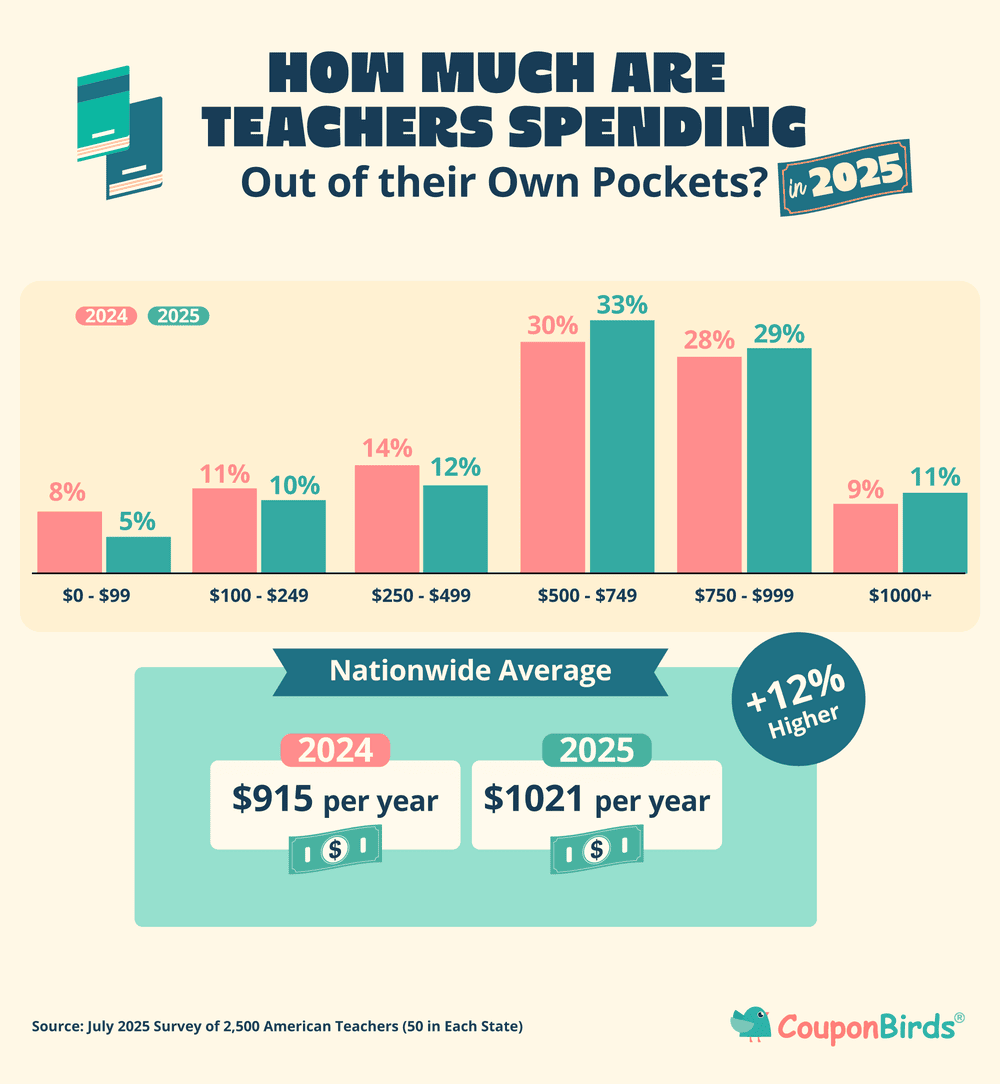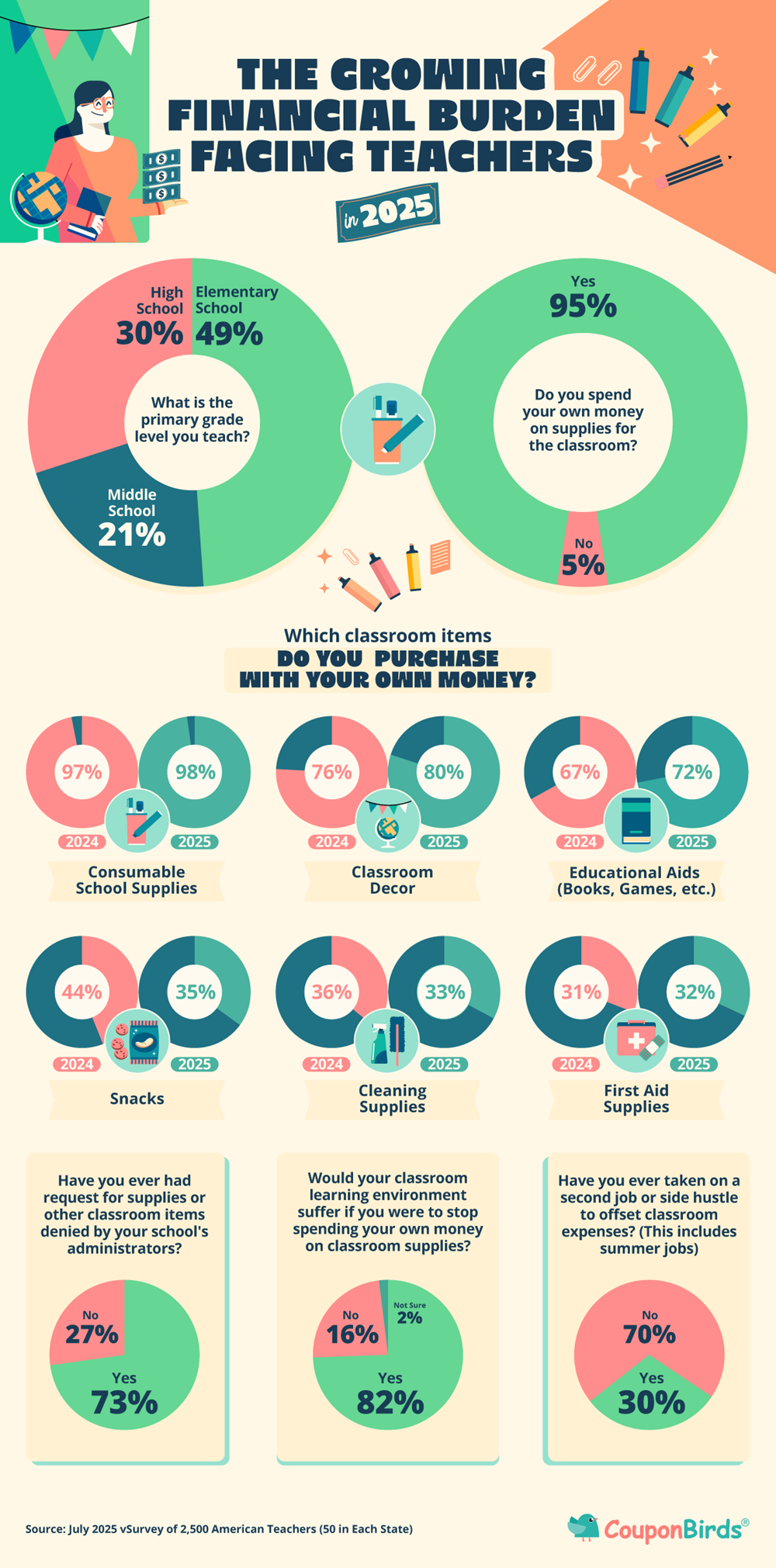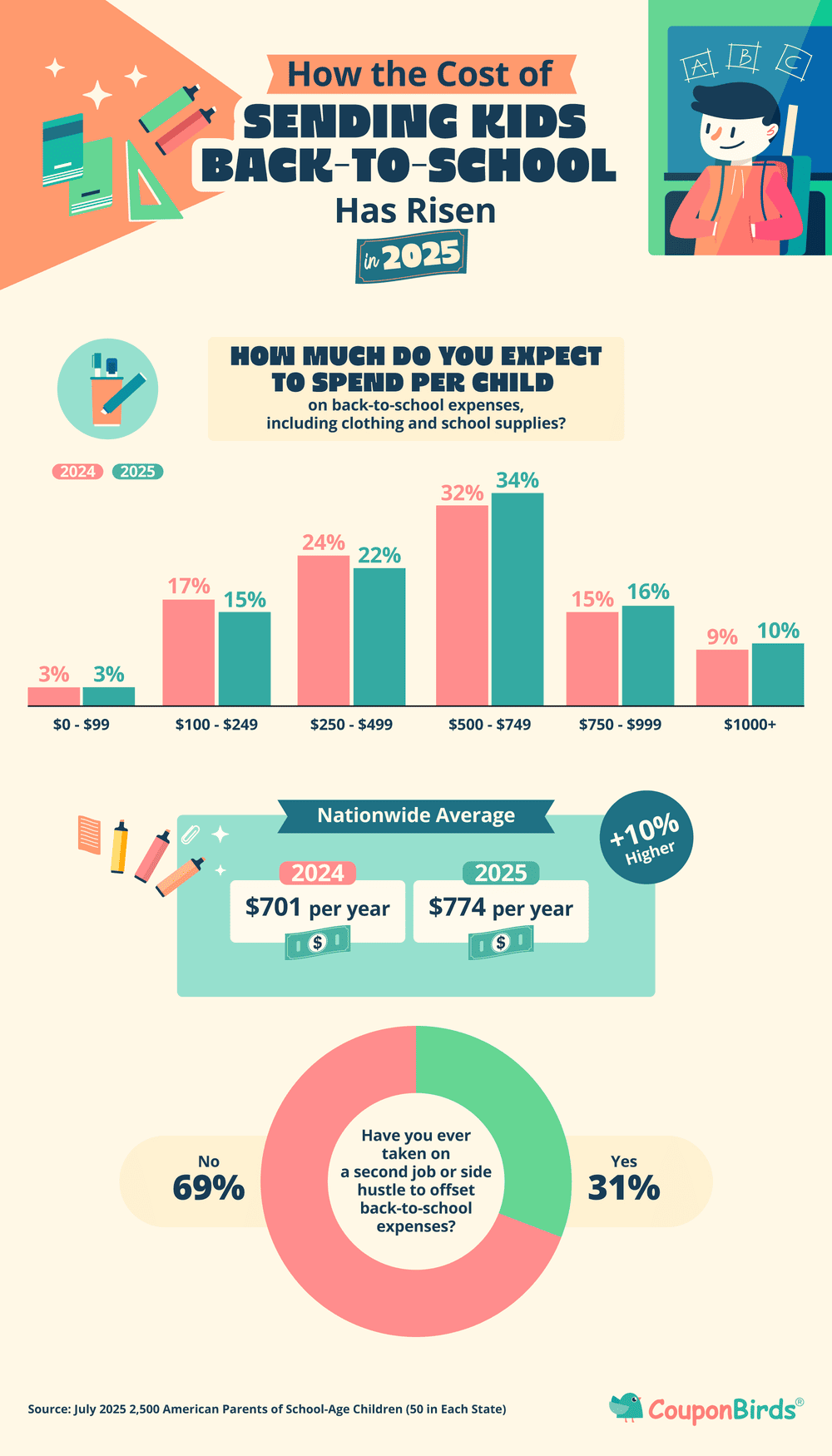Another back-to-school season has arrived, bringing with it the familiar scramble of supply lists, clothes shopping, and, of course, financial stress. But this year hits different. There's an elephant in the classroom that's becoming impossible to ignore, and its crushing financial pressure is squeezing teachers and parents alike.
The cost of keeping classrooms stocked is quickly reaching a breaking point. Teachers aren't just supplementing the odd box of Kleenex anymore; they're footing the bill for essentials that keep their classrooms functioning. Meanwhile, parents face their own uphill climb, trying to keep up with back-to-school demands on tighter and tighter budgets.
As a continuation of our study from last year, we're taking an updated look at how the financial burden on already underpaid teachers and stretched-thin parents has become even more critical in 2025.
Key Takeaways
-
Teachers now average $1,021 in annual out-of-pocket classroom spending, up 12% from 2024's already hefty $915
-
Pennsylvania teachers top the list at $1,637 out of pocket, while Nebraska educators spend the least at $473
-
30% of teachers work second jobs to afford classroom expenses, up from 26% in 2024
-
Parents expect to spend an average of $774 per child on back-to-school necessities, a 10% jump from 2024
-
30% of teachers and 31% of parents pick up a second job or side hustle to cover costs, both up from last year's reported 26% for teachers and 28% for parents
When we first examined the financial strain on educators and families preparing for school last year, teachers were already spending an untenable $915 of their own money despite struggling with below-market salaries. One year later, the burden has grown considerably heavier.
The 2025 data shows virtually every metric has worsened, often with double-digit increases. This comes despite the fact that teachers earn just 73 cents for every dollar made by similarly educated professionals, according to the Economic Policy Institute. Teachers nationwide now expect to spend 12% more on classroom supplies compared to last year. The financial burden isn't just growing; it's accelerating at a pace that far outstrips both inflation and wage growth.

How Much More Are Teachers Spending in 2025?
When the system falls short, teachers are regularly left to pick up the slack, not just in time and energy, but in actual dollars. Curious how deep that commitment runs? Here's how much of their own money they expect to pour into their classrooms in 2025:
-
$1 - $99: 5%
-
$100 - $249: 10%
-
$250 - $499: 12%
-
$500 - $749: 33%
-
$750 - $999: 29%
-
$1000+: 11%
Teachers now expect to spend an average of $1,021 per year out of pocket, a number that speaks volumes about their commitment to education, even in the face of mounting financial strain.
More teachers are crossing into the $500+ range, with 73% now spending at least half a grand annually. The $1000+ category grew to 11%, representing educators who spend nearly a full paycheck on their classrooms.
Red States or Blue, the Bill Still Comes Due
Classroom essentials are expensive just about everywhere, but disparities in funding and district policies leave unequal gaps across the nation. A closer look at state-by-state data reveals just how uneven the financial burden on teachers has become across the country.
Highest Spending States:
-
Pennsylvania: $1,637
-
North Carolina: $1,632
-
Arizona: $1,581
-
Texas: $1,550
-
Missouri: $1,527
Lowest Spending States:
-
Nebraska: $473
-
West Virginia: $502
-
Oklahoma: $545
-
Louisiana: $565
-
South Dakota: $569
Some states saw explosive growth: Hawaii jumped 35%, California surged 29%, and Idaho increased 29%. Local funding gaps, rising supply costs, and uneven policy support are forcing educators to personally cover more than ever before, simply to maintain a nurturing environment.
Walk into any American classroom and you'll find evidence of teacher spending. From the decorative Presidential borders making bland walls inviting to the jumbo bottle of hand sanitizer by the door, educators' personal investments are impossible to miss. And this year, 95% of teachers report spending their own money on supplies, up from an already staggering 93% last year.

Which Classroom Supplies Are Teachers Paying For?
Today's teacher shopping lists extend far beyond basic supplies. The data shows educators forking over their hard-earned cash for:
-
Consumable School Supplies: 98%
-
Classroom Decor: 80%
-
Educational Aids (Books, Games, etc.): 72%
-
Snacks: 35%
-
Cleaning Supplies: 33%
-
First Aid Supplies: 32%
Notice the uptick in educational aids and classroom decor. Teachers aren't just filling gaps anymore. They're creating learning environments from scratch, often after having supply requests denied. This year, 73% of teachers report having requests for materials rejected at some point, forcing them to choose between empty classroom walls and empty wallets. And the breakdown by grade level shows elementary teachers bearing the heaviest load:
-
Elementary School: 49% (a significant jump from 41% last year)
-
Middle School: 21%
-
High School: 30%
What drives this spending? Ask teachers, and 82% will tell you their classrooms would suffer without it. Only 16% believe they could maintain quality learning environments using school-provided resources alone. That confidence gap has widened from last year, when 77% felt their personal spending was essential.
Parents Feel the Squeeze Too
While teachers fund classrooms, parents face their own mounting costs. The average back-to-school spending per child reached $774, up 10% from last year's $701.
-
$0 - $99: 3%
-
$100 - $249: 15%
-
$250 - $499: 22%
-
$500 - $749: 34%
-
$750 - $999: 16%
-
$1000+: 10%

That $774 per child cost for the back-to-school season covers everything from pencils and notebooks to shoes and subject-specific supplies. And, much like teacher spending, the cost can look very different from state to state.
Highest-Spending States for Parents:
-
New York: $1,348
-
California: $1,304
-
Florida: $1,237
Lowest-Spending States for Parents:
-
Louisiana: $327
-
Mississippi: $356
-
Kansas: $373
When 30% of teachers and 31% of parents are turning to additional income streams just to make ends meet, it's not about extravagance; it's about survival. We're not talking laptops and lab kits, but rather basics like notebooks, pencils, and folders.
The jump for both groups in just one year underscores a troubling trend: covering back-to-school costs increasingly means juggling weekend shifts, late-night side gigs, or summer hustles. And for those who aren't picking up extra jobs? They're clipping coupons, scouring the internet for discount codes, chasing sales, and planning months ahead just to make it all work.
Making It Work: Tips for Stretching Every Dollar
While we hold our collective breath waiting for systemic change, teachers and parents need strategies to survive right now. Here's how to make every dollar count:
-
Don't overlook dollar stores: Stock up on basics like notebooks, folders, pencils, and glue sticks for a fraction of the price
-
Hunt for online coupon codes: Install browser extensions like CouponBirds SmartCoupon Coupon Finder
-
Flash that teacher ID: Many retailers offer educator discounts year-round (Office Depot, Target, Michaels, and more), not just during back-to-school season
-
Join teacher swap groups: Find them on Facebook and local social media where educators trade supplies and coordinate bulk purchases
-
Check for free teacher stores: Many cities have nonprofit supply centers like Teachers' Treasures in Indianapolis that provide free materials to public school educators
-
Start online wishlists early: Set up Amazon or DonorsChoose lists in early summer when charitable giving tends to spike
-
Time your shopping right: Hit late July sales when retailers clear inventory, then circle back in mid-September for deep clearance discounts
-
Remember what really matters: Kids need teachers who care and parents who support them, not color-coordinated everything or the latest kicks
Fancy supplies rarely make a difference, but having basic materials shouldn't require financial sacrifice. Until things improve, we'll keep documenting these rising costs, sharing survival strategies, and advocating for the teachers and families who make education possible, one out-of-pocket purchase at a time.
Methodology
Our survey was conducted in July 2025 across a pool of 2,500 American teachers (50 per state) and a pool of 2,500 American parents of school-age children (50 per state). The teacher pool was 69% women, 29% men, and 2% other gender identities. The parent pool was 54% women, 45% men, and 1% other. This follows the same methodology as our 2024 study, allowing for direct year-over-year comparisons of spending trends and financial burdens on educators and families.

This work is licensed under a Creative Commons Attribution-ShareAlike 4.0 International License.
Comments